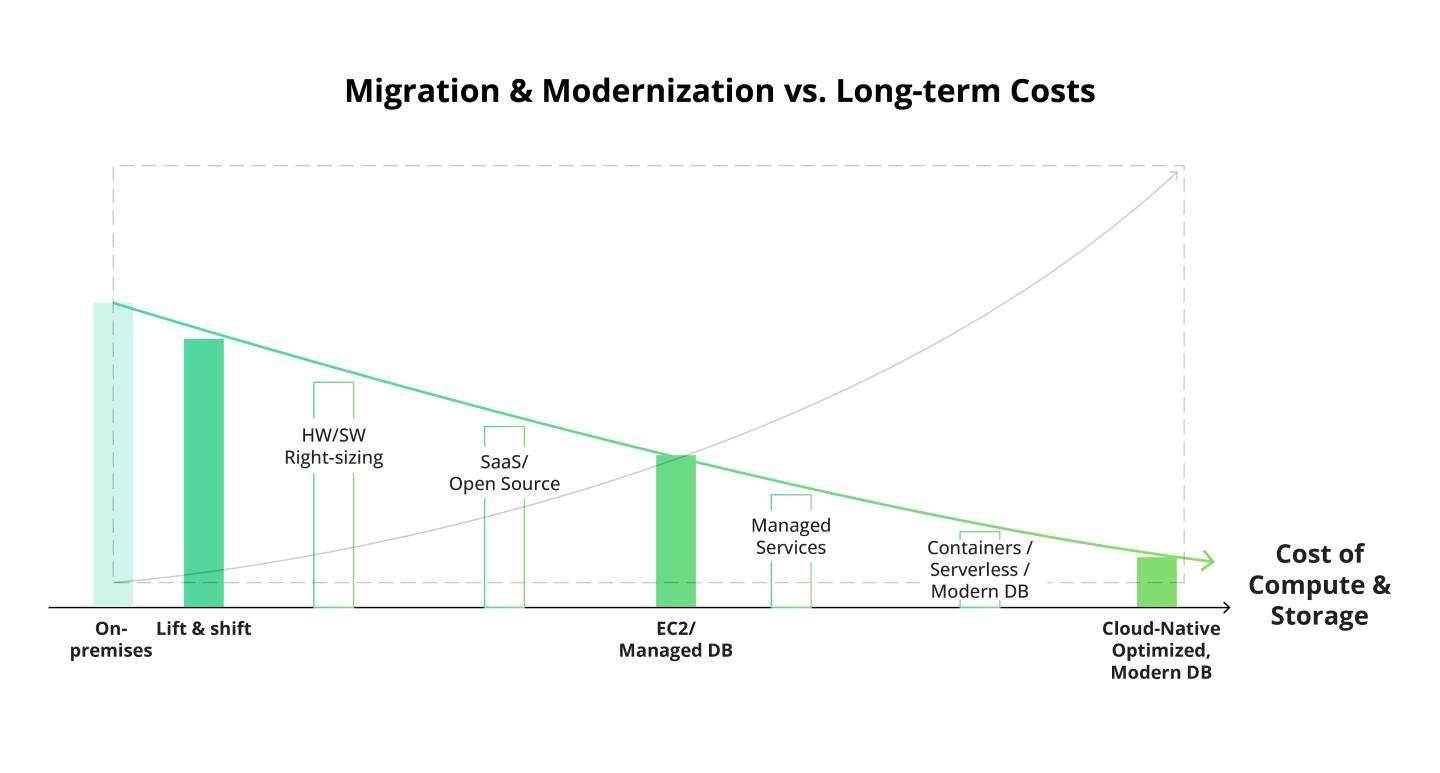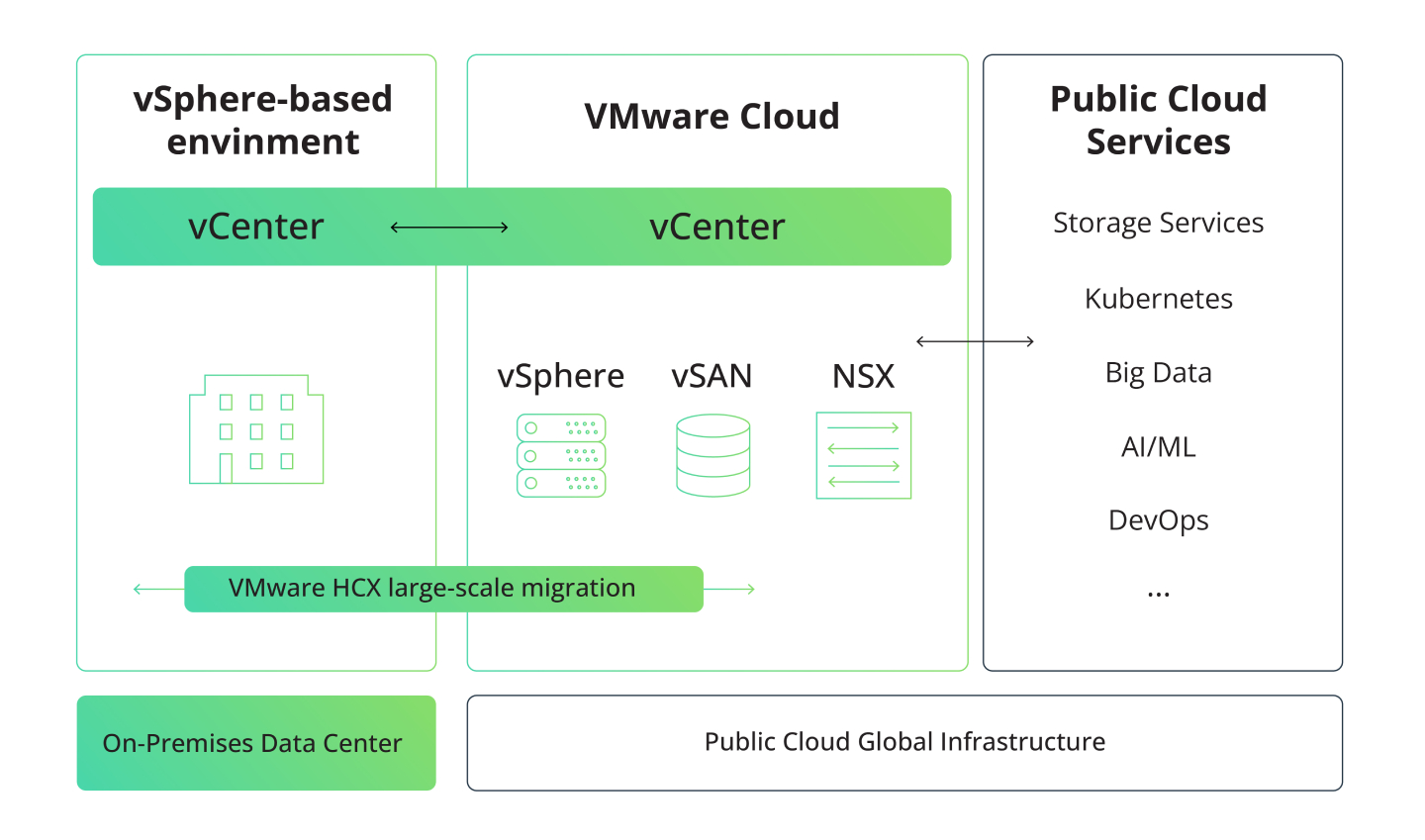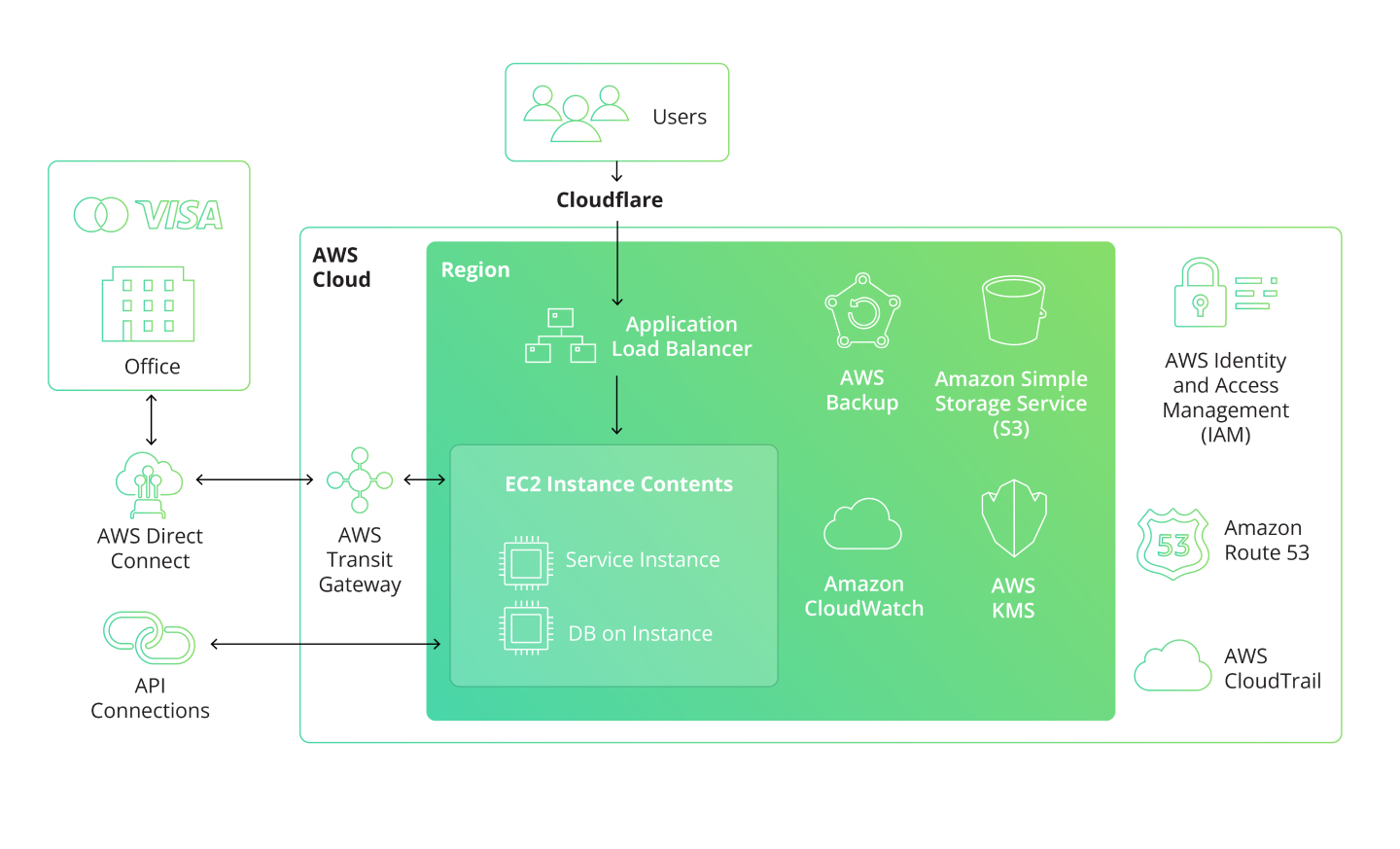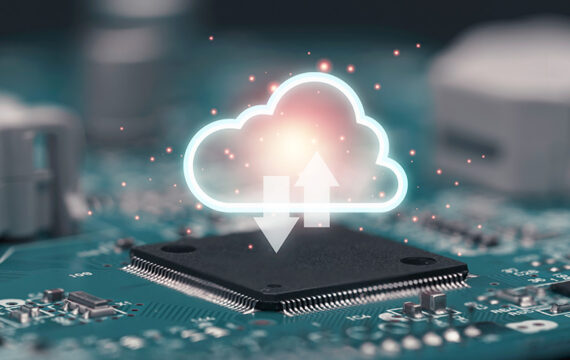Migration from VMware is all but mandatory after its acquisition by Broadcom. On-premise VMware customers have a tough choice: keep using legacy VMware without support, start spending an additional 150% (or more), move from VMware to another hypervisor, or move from VMware to the cloud.
As cloud migration services experts, we’re here to explain the pros and cons of your VMware Cloud migration options. We’ll orient you to the new VMware subscription ecosystem, offer guidance on migrating your VM workloads, and share case studies about successful cloud migrations.
It’s not easy to weigh the relative strengths and costs of migrating VMware to Google Cloud, Azure, or AWS. We’ve been helping companies like SEP build data solutions with VMware and cloud for many years, so we’ve learned all the ins and outs of building hybrid solutions with VMware and cloud. However, in the current context, hybrid may no longer be a viable option with the 5-6x price increase for VMware. That means that the reality has drastically changed and we no longer can rely on the solutions that worked well before.
Understanding the VMware landscape after acquisition

In April 2024, Broadcom CEO Hock Tan admitted on the VMware blog that “this level of change has understandably created some unease among our customers and partners” in the months after the acquisition. Let’s explore the big changes to the VMware portfolio:
Introduction of subscription model
Broadcom ended perpetual licenses. All new VMware sales will be cloud-based Software-as-a-Service subscriptions.
The bad news is that subscription-based models and core-based pricing can lead to higher and more variable expenses, particularly for businesses with fluid workloads. The unpredictability of monthly costs is particularly hard on smaller organizations with tighter margins.
There is a silver lining: the new pricing model offers flexibility without long-term financial commitments. The ability to scale cloud resources up and down could save costs for seasonal or fluctuating workloads.
Loss of security and support for on-premise customers
Broadcom has announced the end of support for existing perpetual licenses. As of this writing, it’s offering disconnected subscription options to keep your VMware workload on-premise.
Broadcom’s hardline position on VMware licenses softened a bit with April 2024 announcements from CEO Hock Tan. He said that expired perpetual license holders would (eventually) get access to zero-day patches, and Broadcom had extended support to “many customers who came up for renewal while these changes were rolling out.”
Unit model change to per-core licensing
In addition to switching to a SaaS model, Broadcom also changed VMware’s computing parameters and implemented core-based pricing. In the old model, VCenter was always an instance, and VSphere was CPU-based with an allowance for 32 ports. Broadcom has restricted licensing to 16 cores. If you had VMware on a 20-processor core, you’ll need two licenses.
Unfortunately, the lack of price transparency makes it hard to predict your new costs until you get a quote from Broadcom. Existing VMware customers have reported increases of 100% to 600%, or costs rising from $8 million to $100 million.
Short-lived subscription upgrade program
VMware briefly advertised a subscription upgrade program (SUP) to help customers adjust to the new SaaS subscription model. This program included discounted subscriptions for perpetual license holders and a 3-year grace period to make the shift.
However, by March 2024, Gabriel Zechbauer at Deloitte called the SUP program “completely obsolete because now Broadcom is kind of forcing the customers — especially those with contract renewals — into the SaaS model.”
Chaotic changes to VMware partner program
It’s safe to say that Broadcom mishandled changes to VMware’s partner program. On the Friday before Christmas 2023, the company sent a partnership termination notice to every partner in the VMware channel organization, regardless of its size or revenue.
The notice said partners may or may not be invited back to VMware’s reimagined partner ecosystem, causing chaos over the holidays.
End of free edition and uncertainty about VMware’s roadmap
We know that VMware is sunsetting 56 products as part of its portfolio simplification. The free edition of VMware vSphere Hypervisor is one of them.
If you ride out the current changes, what will Broadcom do in the future?
Broadcom’s acquisition history holds some clues since it appears to be repeating previous acquisition plans with VMware. In its acquisitions of CA and Symantec, Broadcom cut sales and marketing investment by 22% and R&D by 3%.
Customer options: Navigating the new VMware ecosystem
On-premise VMware customers have three options: accept VMware’s new terms, switch to a different hypervisor, or migrate VMware to cloud alternatives. Let’s explore each.
Option 1: Keep using VMware on-premises
You could choose to accept VMWare’s new terms. You can keep using VMWare if you’re willing to start paying them more.
But it should go without saying that using VMware on-premises without accepting VMWare’s new terms is not a viable option for the long term. Maintaining legacy infrastructure without support or upgrades beyond bare-bones zero-day patches is just too risky.
Option 2: Switch to a competing hypervisor
VMware isn’t the only hypervisor—or virtual machine monitor—on the market. Let’s look at the pros and cons of a few alternatives to VMware:
Microsoft Hyper-V
Hyper-V works well with Windows Server and other Microsoft tools. It offers strong performance and reliability. However, it may need additional training for IT staff and doesn’t offer as much cross-platform compatibility as VMware.
Citrix Hypervisor
Citrix Hypervisor is excellent for performance and scalability, and It’s ideal for big enterprises with complex virtual environments. It also has a free open-source version, Xen. Setup can be complex, though. Premium support requires a subscription, and Citrix costs more than some alternatives.
Nutanix AHV
Nutanix AHV is an open-source hypervisor integrated with Nutanix’s platform. It’s the best and most cost-effective for Nutanix setups. This makes management easier, and it’s included with Nutanix Hyperconverged Infrastructure (HCI) pricing. Consider the total cost of ownership for Nutanix and whether its complexity suits your organization’s needs.
Red Hat Virtualization (RHV)
Red Hat Virtualization, based on free and open-source Kernel-based Virtual Machine (KVM), offers flexibility and works well with Red Hat products. That said, it could be tricky to manage if your team isn’t familiar with Red Hat. Support is solid but costs more.
Oracle VM VirtualBox
Oracle VM is feature-rich, open-source, and free to use. It’s optimized for Oracle applications with centralized management through Oracle VM Manager. This option is ideal for Oracle-heavy environments, but be aware that it doesn’t have extensive third-party ecosystem integration or advanced management tools.
Option 3: Migrate VMware to AWS, Azure, or Google Cloud
When you migrate your VMware to cloud-native alternatives, you can still keep nearly all the capabilities of VMware Cloud and gain all the benefits of the public cloud.
Benefits of VMware migration to AWS, Azure, or Google Cloud
- Cost savings: Migrating your VMs to the cloud reduces the need to maintain expensive on-premises hardware and maintenance.
- Scalability: While your hardware has a fixed capacity, cloud platforms let you scale compute resources up or down based on demand.
- Modernization opportunities: Cloud platform updates give you access to the latest technologies and innovations without costly hardware upgrades.
- Security and compliance: Cloud providers make enormous investments in security measures, which will strengthen your security posture and stay compliant with industry standards
- Enhanced disaster recovery: The Big 3 have the infrastructure to ensure business continuity, reducing downtime and data loss in the event of a disaster.

Migration and modernization vs. long-term costs
When you migrate VMware to the cloud, calculating ROI involves more than just subscription costs.
Initial investment and resources for VMware to cloud migration
Migrating VMware workloads to the cloud will take an upfront investment of time, money, and resources. Planning and executing the migration and overlap of new and old workloads during the transition are all costly. Organizations must also allocate resources to train staff to manage new cloud environments effectively.
Cost savings and operational efficiency of VMware migration to cloud
Over time, cloud migration can lead to significant cost savings and improved operational efficiency. Cloud providers offer scalable resources, which can reduce the need for expensive on-premise hardware and maintenance. The pay-as-you-go pricing models allow for ad-hoc scalability with better cost management, aligning expenses with actual usage and growth. Cloud platforms also offer automation and managed services that reduce the burden on IT staff, freeing up resources.
New opportunities for innovation with VMware on GCP, Azure, or AWS
The competitive cloud market supports ongoing innovation and adaptability. Cloud platforms continuously update their services, offering the latest technologies and improvements. Moving VMware to the cloud will give you access to cutting-edge tools and capabilities without the need for frequent, costly hardware upgrades.
Option to retire hypervisor license costs after migration
Once you have migrated your VMs to the cloud, you’ll find yourself with more options. If you get rid of VMWare without moving to another hypervisor, you’ll be able to remove the virtualizer line item from your budget altogether.
Choosing the right cloud platform for VMware migration: AWS, Azure, or GCP
Since every business has a different tech stack, budget, and business requirements, there’s no single best platform for VMware Cloud migration.

Source: Vembu
Let’s examine the pros and cons of migrating to each major cloud provider: AWS, Azure, and GCP.
Amazon Web Services (AWS)
Amazon was the first of the cloud services giants and maintains the largest share of the cloud market. Amazon Elastic Cloud 2 (EC2) has high availability, scalability, and advanced security features to support VMware applications.
VMware to AWS migration was previously supported with VMware Cloud on AWS. As of April 30, 2024, AWS and its channel partners stopped selling VMware Cloud on AWS. VMware Cloud migration to AWS is now only available through Broadcom.
We’ve outlined the pros and cons of migrating VMware to AWS:
Potential Benefits of migrating VMware to AWS:
- Extensive expertise: Since AWS was the de facto cloud for VMware it has many tech experts and architects who have hands-on experience migrating VMware workloads to the cloud and numerous guidelines for partners.
- Many migration tools: AWS provides a range of tools and services to facilitate smooth and efficient migration. These include AWS Migration Hub, AWS Application Migration Service, and AWS Database Migration Service, which help streamline the process and reduce downtime.
- Scalability and flexibility: AWS’s scalable infrastructure allows organizations to adjust resources based on demand, ensuring cost-efficiency and flexibility.
- Robust security and compliance: AWS has advanced security features and compliance certifications to protect data and applications.
- Additional investment: Through the Migration Acceleration Program (MAP) and AWS VMware Migration Accelerator, customers can access various AWS investments in the form of AWS service credits or partner investments, intended to help customers offset one-time migration expenses
Microsoft Azure
Azure VMware Solution (AVS) is Microsoft’s tool for migrating VMware to Azure.
Consider these pros and cons of putting VMware on Azure:
Potential Benefits of migrating VMware to Azure:
- Cost efficiency: VMware to Azure migration gives you a variety of pricing options.
- Access to Azure services: Entra ID usage for SSO with your organization AD accounts. Gain flexibility and functionality by seamlessly integrating Azure Data Lake, Azure Synapse Analytics, Power BI, Data Factory and Azure AI Studio and use SaaS Databases instead of managed instance on VM.
- Scalability and flexibility: Azure VMw Solution supports dynamic scaling, making it easier to handle fluctuating workloads and future growth
- Robust security and compliance: Azure’s extensive compliance coverage is good for industries with strict regulatory requirements.
Considerations for migrating VMware to Azure:
- Skills and training: If you migrate VMware to Azure, IT teams unfamiliar with Microsoft environments may face a steep learning curve.
- Vendor lock-in: Microsoft is notoriously sticky, and once you become dependent on its interconnected services, it may be hard to switch to another vendor.
Google Cloud Platform (GCP)
Google’s innovation-first infrastructure stands out for high-speed performance, transformative solutions, and ease of use. GCP takes care of deployments, upgrades, and health monitoring of VMware components, including vCenter, NSX, and ESXi.
Google Cloud offers an effortless migration path through its Google Cloud VMware Engine service.
VMware to GCP migration has its pros and cons, too:
Potential benefits of migrating VMware to GCP:
- Enhanced monitoring and support: GCP handles infrastructure management, which ensures reliable performance and reduces the burden on IT teams.
- Infrastructure Agility: Scaling resources for VM environments is easy with GCP’s on-demand self-service provisioning.
- Pay-as-you-go pricing: Google Cloud offers double-digit savings for VMware workloads compared to other providers, and its pay-as-you-go model can cut costs.
- Continuous Improvement: Google’s focus on rapid development and innovation means you can count on having access to the latest technologies.
- Security: Google Cloud is compliant with major security certifications. It keeps security for the underlying cloud infrastructure and provides tools to protect workflows and data.
Considerations for migrating VMware to GCP:
- Challenger status: GCP has the smallest market share of the Big Three, so its third-party integrations, enterprise-centric services, and support may not be as mature.
- Service complexity: Managing GCP services can be complex, especially for organizations new to the platform.
- Vendor lock-in: Like the others, Google provides an entire ecosystem of services and wants to lock you in, so it’s hard to leave.
Preparation for VMware migration to the cloud
Inventory of current VMware workloads and dependencies
The first thing you’ll need to do is make a comprehensive inventory of your existing VMware workloads.
Use tools like VMware vCenter Server or other inventory utilities to gather detailed information about your infrastructure. Identify:
- Every VM
- Their configurations
- The applications they run
- Dependencies between workloads
- Stakeholders to keep informed about the migration process
Creating a migration strategy and plan
Include stakeholders from all affected departments to help inform your migration strategy. With their input, you’ll outline the goals, timelines, and resources required for the migration. Your migration plan should also address potential risks and how to mitigate them.
A well-defined plan ensures all affected parties are on the same page, so there are no surprises.
Steps for effective pre-migration preparation
In the earliest stages, pre-migration preparation looks the same whether you intend to migrate VMware to Azure or are planning a VMware to GCP migration.
Follow these steps to prepare for any kind of VMware migration to the cloud:
- Inventory VMs and assess dependencies: Gather detailed information about your VMs, their workloads, and dependencies. Tools like VMware vCenter Server will help. Categorize workloads by environment and criticality and create a centralized repository for all migration-related data.
- Define scope and objectives: Based on the inventory and dependencies, clearly define the migration project’s scope and objectives. Decide which environments and data centers will be included in the initial discovery and migration phases.
- Develop a detailed migration plan: Outline a comprehensive plan with timelines, resources, and risk mitigation strategies. Include specific steps and establish accountability for each phase of the migration, aligning all team members and stakeholders.
- Test and validate migration tools: Test in a controlled environment to ensure everything works as expected.
VMware Cloud migration process
There are many cloud migration strategies to choose from for your VMware Cloud migration process. Let’s look at three main key cloud migration approaches.
Rehosting
Definition: Rehosting, also known as lift-and-shift, involves moving applications to the cloud without changing the underlying architecture or code.
This is the simplest and quickest migration method: transferring VMs to the cloud as-is. This approach minimizes downtime and risks. Your VMs and workloads won’t be optimized for the cloud yet, but they’ll be on the cloud, and you can make adjustments as needed.
Replatforming
Definition: Replatforming involves moving applications to the cloud with some modifications.
Replatforming is sometimes called “lift, tinker, and shift” because it involves making some modifications. By optimizing your VMs and workloads for cloud infrastructure before migrating them, you’ll be better able to take advantage of cloud benefits like managed services.
Refactoring
Definition: Refactoring involves re-architecting and rewriting applications to take full advantage of cloud-native features and services.
Refactoring when you move VMware to the cloud could involve breaking down monolithic applications running VMs into microservices or converting them into containers. This “full rebuild” approach is resource-intensive but can significantly improve performance.
Challenges of VMware migration to cloud
Moving VMware workloads to the cloud can be tricky, even when migrating to VMware Cloud on AWS. Here are some of the VMware to cloud migration challenges we’ve seen organizations struggle with:
Ensuring compatibility
The last thing you want is to find out is that your VMs don’t work well in the new environment. Check that the cloud platform supports all aspects of your current VMware setup, including any older or customized applications in your stack.
Protecting data during transfer
Keep your network secure during migration by setting up the cloud environment with measures to prevent breaches and ensure data stays safe. Use strong encryption, control access, and monitor the network continuously.
Minimizing operational disruption
Migration shouldn’t stop your business. Plan carefully to avoid disruption—schedule migrations during quiet times, break the process into phases, expect the unexpected, and make contingency plans.
Optimizing performance post-migration
Depending on your migration method, your workloads may need adjustments to run efficiently in the cloud. To improve performance, tweak resource settings, adjust VMs, and use cloud services. Skipping this step could lead to higher costs and delays.
Cloud migration case studies and success stories
Cloud migration is one of our specialities at Intellias. Whether you decide to migrate to VMware Cloud on AWS or move VMware to another host, we provide end-to-end services including initial assessment, planning, execution, and post-migration support.
We solve challenges like speeding up time to market, scaling business, securing infrastructure, optimizing costs, and streamlining collaboration. We’ve helped leading companies across telecom, healthcare, finance, and banking with services, including cloud development.
Take a look at two companies that recently needed to migrate infrastructure and VMs from on-premises data centers to the cloud.
Guided infrastructure migration for an AgriTech corporation
A leading international AgriTech corporation faced significant risks due to geopolitical instability, including on-premise VMware infrastructure. Intellias guided the company’s migration to Azure, helping to re-platform its system from VMs to containers in AKS for better business resilience in a high-risk environment.

Technologies: Microsoft stack, Azure, AKS, ADO, MySQL flexible server, Azure storage, Azure monitoring, WAF, Grafana APM.
Migration approach: Re-platforming, shifting from traditional VMs to container orchestration.
Business results:
- Enhanced business resilience and operational continuity during geopolitical risks
- Improved resource flexibility and reliable performance
- All the benefits of closed computing: resource flexibility, reliable performance, and operational cost optimization
Cloud migration for an international finance company
An international finance firm specializing in payments processing and analytics struggled with growth due to a legacy on-premise data center. Intellias migrated its entire infrastructure to AWS. This optimized performance and costs and helped the company enact a robust disaster recovery plan, significantly enhancing its compliance posture and boosting business agility.

Technologies: AWS, EC2 Instances, AWS IAM, VPC Subnets, AWS KMS, AWS Transit Gateway, AWS Direct Connect, Amazon S3, Amazon CloudWatch, AWS CloudTrail
Migration Approach: Lift-and-shift with additional optimizations for disaster recovery and security.
Business Results:
- Reduced infrastructure costs with a guaranteed mid/long-term ROI
- Enhanced flexibility, resilience, and compliance with global data handling regulations
- Improved productivity thanks to modern cloud technologies
Key considerations for VMware Cloud migration
AWS, Azure, and Google Cloud all have robust platforms with good security. The decision isn’t straightforward, and you’ll have to evaluate your needs carefully. As you take your next steps to migrate from VMware to AWS, Azure, or GCP, it will help to keep these factors in mind:
Workload prioritization
You don’t need to migrate all workloads at once. Consider starting with less critical workloads to test the migration process before moving mission-critical applications. A phased approach reduces risk and allows time to address any issues that arise.
Security and compliance
Migrating to the cloud introduces new security and compliance challenges. Ensure that your cloud provider meets your organization’s security standards and regulatory requirements. Also, plan for data encryption, access controls, and regular security audits during and after the migration.
Cost management
Cloud environments offer scalable resources, but costs can spiral out of control if you’re not monitoring them carefully. Establish clear cost management practices before migration: set up budgets, monitor usage, and use cost optimization tools. Research the cost implications of your migration approach—lift-and-shift, re-platforming, or refactoring—to manage expenses effectively.
Migrating critical workloads to the cloud can be daunting, but you don’t have to do it alone. As cloud experts, we can navigate the complexities of any cloud migration. Tell us about your VMware migration needs so we can help position your organization for long-term success.




